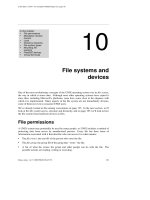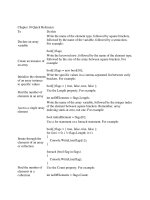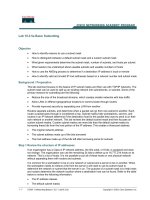linux crash course chapter 10 3
Bạn đang xem bản rút gọn của tài liệu. Xem và tải ngay bản đầy đủ của tài liệu tại đây (199.03 KB, 33 trang )
Chapter 10:
BASH Shell Scripting
Fun with fi
In this chapter …
• Control structures
• File descriptors
• Variables
Control structure tests
• Control structures depend on a test that
equates either true or false
• The test builtin in bash allows logical,
relational, and file property-based tests
• Syntax:
test expression OR
[ expression ]
test expressions
• If expression is true, test returns 0; if false, it
returns not 0 (usually 1)
• Comparing text strings
string1 = string2
string1 != string2
• Comparing numbers
num1 –OP num2
– Where OP can be eq, ne, lt, gt, le, ge
test expressions con’t
• File tests
-option filename
where option can be:
d : file is a directory
y : file exists
f : file is a regular file
Plus many more (check man bash)
Other test-commands
• Instead of test and [ ] you can use other bash
contructs
• ((expression)) can be used for integer
comparisons
• [[expression]] can be used for logical
expressions and string comparisons
• See pages 505-506 for complete list
if … then structure
• Syntax:
if test-command
then
commands
fi
• test-command must evaluate true or false
• commands can be zero or more lines
if … then … else structure
• Syntax:
if test-command
then
commands
else
commands
fi
• Same guidelines as if…then
if … then … elif structure
• Syntax:
if test-command
then
commands
elif test-command
then
commands
…
else
commands
fi
if … then … elif con’t
• You can have one or more elif blocks
• Remember, each elif line is following by a
then statement
• Rather than multiple elif’s, might try a case
statement instead
case structure
• Syntax:
case test-string in
pattern-1)
commands
;;
pattern-2)
commands
;;
…
esac
case structure con’t
• test-string is any string – usually we want to
check the contents of a variable, so we’d use
something like $myvar
• The patterns are similar to ambiguous file
references – so the shell special characters
apply ([ ], ?, *, |)
• If the last pattern is *, it’s a catch all or
default
for … in structure
• Syntax:
for loop-index in argument-list
do
commands
done
• loop-index is a variable name – does not
have to be previously declared
• argument-list is a space-delimited list
for structure
• Syntax:
for loop-index
do
commands
done
• Similar to for … in except values of loopindex are populated with the script’s
command line arguments
while structure
• Syntax:
while test-command
do
commands
done
• commands will continue to be run until testcommand becomes false
until structure
• Syntax:
until test-command
do
commands
done
• commands will continue to be run until testcommand becomes true
break and continue
• break exits a loop structure – jumps down to
after done statement
• continue exits current loop iteration – jumps
down to the done statement, and begins next
loop iteration test
• Used to short circuit loops
select structure
• Syntax:
select varname [in arg1 arg2 …]
do
commands
done
• Similarly to a for loop, varname need not be
declared prior
• If in args omitted, command line arguments
used
select structure con’t
• select structure displays a numbered menu
allowing user to select an arg
• After displaying the menu, select displays the
PS3 prompt – by default it’s #?
• Set PS3 to customize the prompt to
something more intelligible
• The user’s selection (what was actually
typed) is stored in REPLY
File descriptors
• Recall 0<, 1>, 2> … now let’s make more
• Syntax:
exec n> outfile
AND
exec m< infile
• exec associates streams with files
• Then can treat those streams just like the
standard ones
• To close:
exec n>&-
AND
exec m<&-
Array Variables
• Recall we declare bash variables with the
format varname=value
• To declare an array, use:
arrayname=(elements …)
• Array is zero based and referenced via [ ]
• [*] returns all the elements in the array, IFS
delimited
• [@] returns all the elements in the array, for
the purpose of copying entire arrays
Variable Scope
• By default, bash variables have local scope
• To make global, you must use export (or
declare/typeset with –x)
• Variables used in a shell script are local to
the script, unless exported
Special Parameters
•
•
•
•
•
$$ -- the PID of the process running
$? -- the exit status of the last process
$# -- the number of command line arguments
$0 -- the name of the calling program
$n -- the nth command line argument
– ${n} must be used for n > 9
– the shift builtin rotates through the arguments
Null and unset variables
• ${varname:-default} : if varname is not set or
is null, substitutes for default
• ${varname:=default} : if varname is not set or
null, substitues for default and sets varname
• ${varname:?message} : if varname is not
set, displays an error
Functions
• Syntax:
function name () {
…
}
• Note on scope – functions have same scope
as calling script/shell … which means you
can access (or step on!) existing variables









